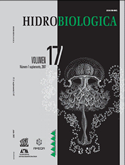Phytotoxicity of the Roundup® Max herbicide on the non-target species Lemna gibba in field and laboratory studies
Keywords:
Macrophytes, phytotoxicity, Roundup®Max, soybean.Abstract
The use of the herbicide formulate Roundup® in transgenic crops of the Pampa´s plains of Argentina has extensively increased, though there is scarce information on its impact on non-target vascular plants from agro-ecosystem related surface waters. Within this frame, the sensitivity of the macrophyte Lemna gibba L. to Roundup® Max was studied in standardized laboratory conditions and field experiments. In the laboratory, phytotoxic effects were assessed on the growth rate (GR) and total chlorophyll content (TCC). The GR was affected at 1 mg/L and TCC at 7.5 mg/L as active ingredient. Effects varied along testing time: toxicity was higher at low concentrations at the beginning, but diminishing during exposure, while at higher concentrations toxicity increments during testing. Also, a reduction of frond and root growth was detected. Field experiments with caged plants placed close to field crops showed an inhibition of 35.5 % in biomass production (dry weight) and 75.5 % in TCC when a dose of 1 kg/ha was applied. Although, in a second dose, only an inhibition effect on TCC of 53.9 % was detected. The assessment of the herbicide drift did not show an influence of this exposure route on the plants for the studied scenery. The lowest glyphosate concentration producing an effect in the laboratory is in agreement with the detected levels of the herbicide in the water body associated with effects in field experiments.Downloads
Downloads
Published
How to Cite
Issue
Section
License
Los autores/as que publiquen en esta revista aceptan las siguientes condiciones:
De acuerdo con la legislación de derechos de autor, HIDROBIOLÓGICA reconoce y respeta el derecho moral de los autores, así como la titularidad del derecho patrimonial, el cual será cedido a la revista para su difusión en acceso abierto.
Publicar en la revista HIDROBIOLÓGICA tiene un costo de recuperación de $500 pesos mexicanos por página en blanco y negro (aproximadamente 29 dólares americanos) y $1000 pesos por página a color (aproximadamente 58 dólares americanos).
Todos los textos publicados por HIDROBIOLÓGICA sin excepción se distribuyen amparados bajo la licencia Creative Commons 4.0Atribución-No Comercial (CC BY-NC 4.0 Internacional), que permite a terceros utilizar lo publicado siempre que mencionen la autoría del trabajo y a la primera publicación en esta revista.
Los autores/as pueden realizar otros acuerdos contractuales independientes y adicionales para la distribución no exclusiva de la versión del artículo publicado en HIDROBIOLÓGICA (por ejemplo incluirlo en un repositorio institucional o publicarlo en un libro) siempre que indiquen claramente que el trabajo se publicó por primera vez en HIDROBIOLÓGICA.
Para todo lo anterior, el o los autor(es) deben remitir el formato de Carta-Cesión de la Propiedad de los Derechos de la primera publicación debidamente requisitado y firmado por el autor(es). Este formato se puede enviar por correo electrónico en archivo pdf al correo: enlacerebvistahidrobiológica@gmail.com; rehb@xanum.uam.mx (Carta-Cesión de Propiedad de Derechos de Autor).
Esta obra está bajo una licencia de Creative Commons Reconocimiento-No Comercial 4.0 Internacional.


